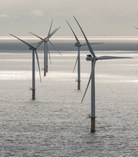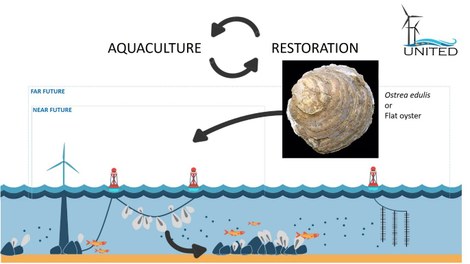UNITED project
Offshore wind, flat oyster aquaculture & restoration, & seaweed research in Belgium

- The Belgian pilot is coordinated by the UGent Laboratory for Aquaculture and Artemia Reference Center. The pilot is located in an offshore wind park, operated by Parkwind, in Belgian exclusive economic zone.
- Together with our six partners, the project focuses on synergies between offshore wind production, flat oyster aquaculture and restoration.
- The scour protection around wind turbine poles may encourage the formation of natural oyster reefs while oyster aquaculture and reef restoration may cross-fertilize each other.
- For the first time, flat oyster aquaculture will be tested in offshore wind parks. In addition, seaweed quality grown offshore will be investigated.
Rise and fall of the European flat oyster
The European flat oyster (Ostrea edulis) is a luxury seafood, considered a more valuable and marketable product than the Pacific oyster (Crassostrea gigas). Indigenous to Europe, the flat oyster has been part of our diet for many centuries. Oyster spat – the young oysters – has been collected from rocks for grow-out in ponds since Roman times, and flat oyster aquaculture flourished in Europe in the 18th and 19th centuries. However, overfishing since the 19th century and the occurrence of diseases (such as bonamiasis) in the 20th century (1980s) devastated wild oyster reefs, and recent efforts to obtain cultivated spat have not been successful, with unexplained deaths of larvae and spat. With wild spat becoming rare, aquaculture of flat oyster is now impossible in most traditional rearing areas. In Belgium, flat oysters used to be abundant and formed large oyster reefs, a valuable habitat supporting a unique marine biodiversity. What used to be a key element of the country's biodiversity, cuisine and culture, is almost extinct today.
The opportunity
Will we have to give up eating delicious plates of flat oysters? Maybe not: Belgian offshore wind parks might offer a unique environment to interactively restore oyster reefs and develop aquaculture. Bottom fishing is not allowed in wind parks – and oyster reefs would thus not be damaged. In addition, the hard substrate used as scour protection around wind turbine poles may be the perfect substrate for oyster larvae to settle on and initiate natural oyster reefs. Aquaculture could be developed hand in hand with restoration efforts, as the two activities would enhance each other: aquaculture would provide the initial stocking material to help developing natural reefs and, in the longer term, natural oyster reefs would provide oyster larvae to the aquaculture sector.
The challenge
Co-location of restoration and aquaculture in wind parks looks like a logical choice, but we are still far from its large-scale application. The distance from the coast complicates implementation, operation and maintenance of the structures needed for restoration and aquaculture production, and the same can be said about the harsh sea and weather conditions in the North Sea. Optimal growing conditions of flat oyster are quite specific, and this makes offshore aquaculture and restoration very challenging. The selected scour material must fulfill the technical requirements imposed on scour material in general and, at the same time, creates an attractive habitat for oyster larvae to settle.
UNITED response
UNITED scientists are addressing these challenges by finding the best technical and managerial solutions in a pilot wind farm within the designated zone for offshore wind in the Belgian offshore space (exclusive economic zone). Models to correctly position the longlines are applied, proper systems for spat collection and grow-out are being developed, and several scour protection materials are being tested. In addition, they are combining the culture of flat oyster and sugar kelp on the same longline, and comparing the characteristics of sugar kelp grown nearshore and offshore.
If aquaculture and restoration prove to be feasible in offshore wind parks, a new time of prosperity might start for flat oyster. This blueprint could open the way for new multi-use sites in Belgium, and all we will need to worry about will be: shall we season our flat oysters with lemon, or shall we enjoy their natural open-sea taste? With an additional pleasure: the certainty that flat oysters in our plate have contributed to the restoration of natural reefs and the flourishing nature that goes with them.
UNITED website and social media accounts
Project partners - Belgian pilot
Ghent University
- Laboratory of Aquaculture & Artemia Reference Center
- Maritime Technology Division
- Phycology Lab
- Maritime Institute
Other
- Royal Belgian Institute of Natural Sciences
- Parkwind
- Brevisco (discontinued activities)
- Jan De Nul Group
- Colruyt Group
